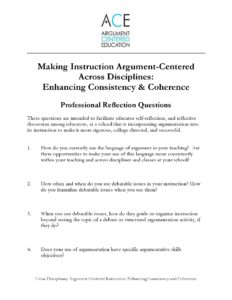
Only Connect: Making Cross-Disciplinary Incorporation of Argument More Coherent & Consistent
Only Connect.
— E. M. Forster, Howard’s End (1910)
When schools implement any “intervention” or improvement initiative there is the inherent challenge in trying to attain not only a fidelity to its core principles, but also a coherence and consistency across classes, teachers, and disciplines. Schools, as intensifying reform waves have come to appreciate ever more deeply, are complex institutions with many moving parts and individual and group intentions and agendas. The service model deployed, and theory of change embraced, by Argument-Centered Education only heightens the difficulty level, and the importance, of achieving cross-disciplinary and faculty-wide coherence and consistency of understanding and implementation.
Since we work with educators collaboratively, building resource adaptations and designing curriculum that argumentalizes a curriculum to which each teacher is committed, argument-centered applications proliferate, vary, and are revised, improved, and assimilated individually across a full school. It is a more complex process than adopting a uniform curriculum or web platform, but its large upside is that it achieves a fullness of teacher investment and commitment that facilitates the larger objective of the work: to build permanent professional capacity within a school’s faculty to use rigorous academic argument and debate in the classroom to make every student authentically college ready (even if not every student chooses to attend college).
One of our strategies to meet the challenge of attaining coherence and consistency as we help schools bring academic argument in to the center of their curriculum and instruction is engage teachers in professional self-reflection on questions related to their standards of use of argument-centered instruction. This guided self-reflection is then prelude to periodic workshops, either within departments or involving teaching faculty across disciplines (sometimes whole schools), which are focused mainly on conversations between teachers about the current states of argument-centered instructional design and implementation, and on what emerge as the best current strategies and ideas for upgrading the work school-wide. The effect of these guided discussions, when effectively moderated, is meaningful advancement toward the coherence and consistency goals, which is (most importantly) generated by the educators within the professional community that they have created.
These questions below are the core of what we use to facilitate educator self-reflection, and reflective discussion among educators, at a school that is incorporating argumentation into its instruction to make it more rigorous, college-directed, and successful. They guide faculty toward the work of attaining coherence and consistency in the implementation of argument-centered instruction.
1. How do you currently use the language of argument in your teaching? Are there opportunities to make your use of this language more consistently within your teaching and across disciplines and classes at your school?
2. How often and when do you use debatable issues in your instruction? How do you formulate debatable issues when you use them?
3. When you use debatable issues, how do they guide or organize instruction beyond setting the topic of a debate or structured argumentation activity, if they do?
4. Does your use of argumentation have specific argumentative skills objectives?
5. What formats of structured argumentation or debating have you used? Are you comfortable with? Do you prefer? Are you interested in getting or learning?
6. How do you or can you use argument in your teaching even when you’re not including in a unit a debate or structured argumentation activity?
7. How do or can students get specific, constructive, timely feedback on their argumentation in your classes?
8. Does your instruction have a rigorous standard of evidence? A rigorous standard of refutation? Are these standards applied consistently?
9. What have been the most successful features of your argument-centered instruction so far? How about the least successful features? What might be done to address what has been less successful?
10. How specifically would you like to use argumentation in upcoming units? How can Argument-Centered Education best support you in this application and implementation?


